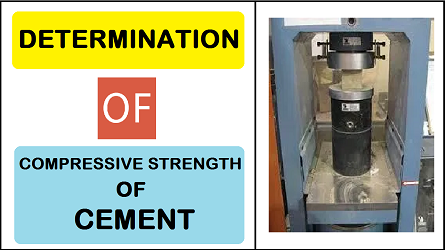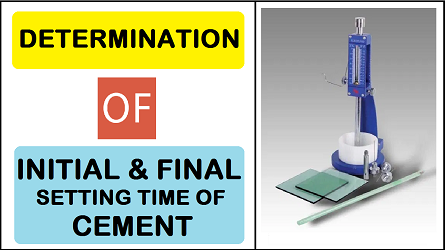Hello Friends, This is Mukesh from Learning Technology. I will tell you in today’s post, Compressive Strength Test of Cement in a very easy way.
Contents
Objective of Experiment
To determine the compressive strength of cement
Apparatus required
1. Non-porous enamel tray
2. Trowel
3. Cube mould of size 7.06 cm
4. Platform vibrator or Equipment for hand compaction
5. Compression Testing Machine
6. Balance to measure weight
Significance of the test
The compressive strength of hardened cement is the most important of all the properties. Therefore, it is not surprising that the cement is always tested for its compressive strength at the laboratory before the cement is used in important works.
Strength Test
The strength test is not done on neat cement paste because of difficulties of excessive sinkage and subsequent cracking of neat cement. Strength of cement is indirectly found on cement-sand mortar in specific proportion. The cubes are prepared for this purpose. The cubes are then tested in compression testing machine at the end of three days and seven days. Testing of cubes is carried out on their three sides without packing. Thus the cubes are tested at each time.
Procedure
Preparation of Cement Mortar Cubes
1. Take 555 grams of standard sand, 185 grams of cement (1.e. ratio of cement to sand is 1:3) in a non-porous enamel tray and mix them with a trowel for 1 minute.
2. Add water quantity (P/4 + 3.0) % of the combined weight of cement and sand and mix the three ingredients thoroughly until the mixture is of uniform colour. The time of mixing should not be less than 3 minutes and not more than 4 minutes.
3. Immediately after mixing fill the mortar into a cube mould of size 7.06 cm.
4. Compact the mortar either by hand compaction in a standard specified manner or on the vibrating table.
5. Place the moulds in a cabin at a temperature of 27 degrees ± 2 degree Celsius for 24 hours.
6. Remove the specimen from the moulds and submerge them in clean water for curing.
READ MORE
- Fineness Modulus of Fine Aggregate
- Determination of Normal Consistency of Cement
- Specific Gravity Test for Bitumen
- Bitumen Penetration Test – Consistency Test
- Softening Point of Bituminous Materials
- Aggregate Abrasion Value Test
- Flash and Fire Points of Bituminous Materials
- Determination of Flakiness and Elongation Index of Coarse Aggregates
Testing of Cement Mortar Cubes
1. Take the cube out of the water at the end of 3 days with a dry cloth. Measure the dimensions of the surface in which the load is to be applied. Let be ‘L’ and ‘B’ respectively.
2. Place the cube in the compressive testing machine and apply the load uniformly at the rate of 35 Newton per millimetre square.
3. Note the load at which the cube fails. Let it be ‘P’.
4. Calculate the compressive strength of the cube by using formula. The compressive strength at the end of the three days should not be less than 16 Newton per millimetre square.
5. Repeat the same procedure (Step 1 to 4) for the other two cubes.
6. Repeat the whole procedure (Step 1 to 5) to find the compressive strength of cube at the end of 7 days and it should not be less than 22 Newton per millimetre square.
Calculation
(a) For 3 days of strength
| Sl. No. | Length (L) in mm | Breadth (B) in mm | Load (P) in N | Compressive Strength in N/mm2 |
| 1 | ||||
| 2 | ||||
| 3 |
Average =
(b) For 7 days of strength
| Sl. No. | Length (L) in mm | Breadth (B) in mm | Load (P) in N | Compressive Strength in N/mm2 |
| 1 | ||||
| 2 | ||||
| 3 |
Average =
Result
Compressive strength of cement at 3 days = ………….. N/mm2
Compressive strength of cement at 7 days = …………… N/mm2







Good Information. Thanks for posting.
You Welcome
thank you sir really good job . may god give you more then your dream.
Thanks brother